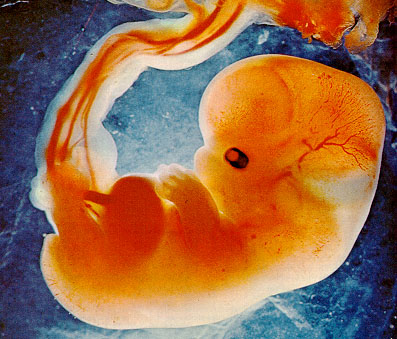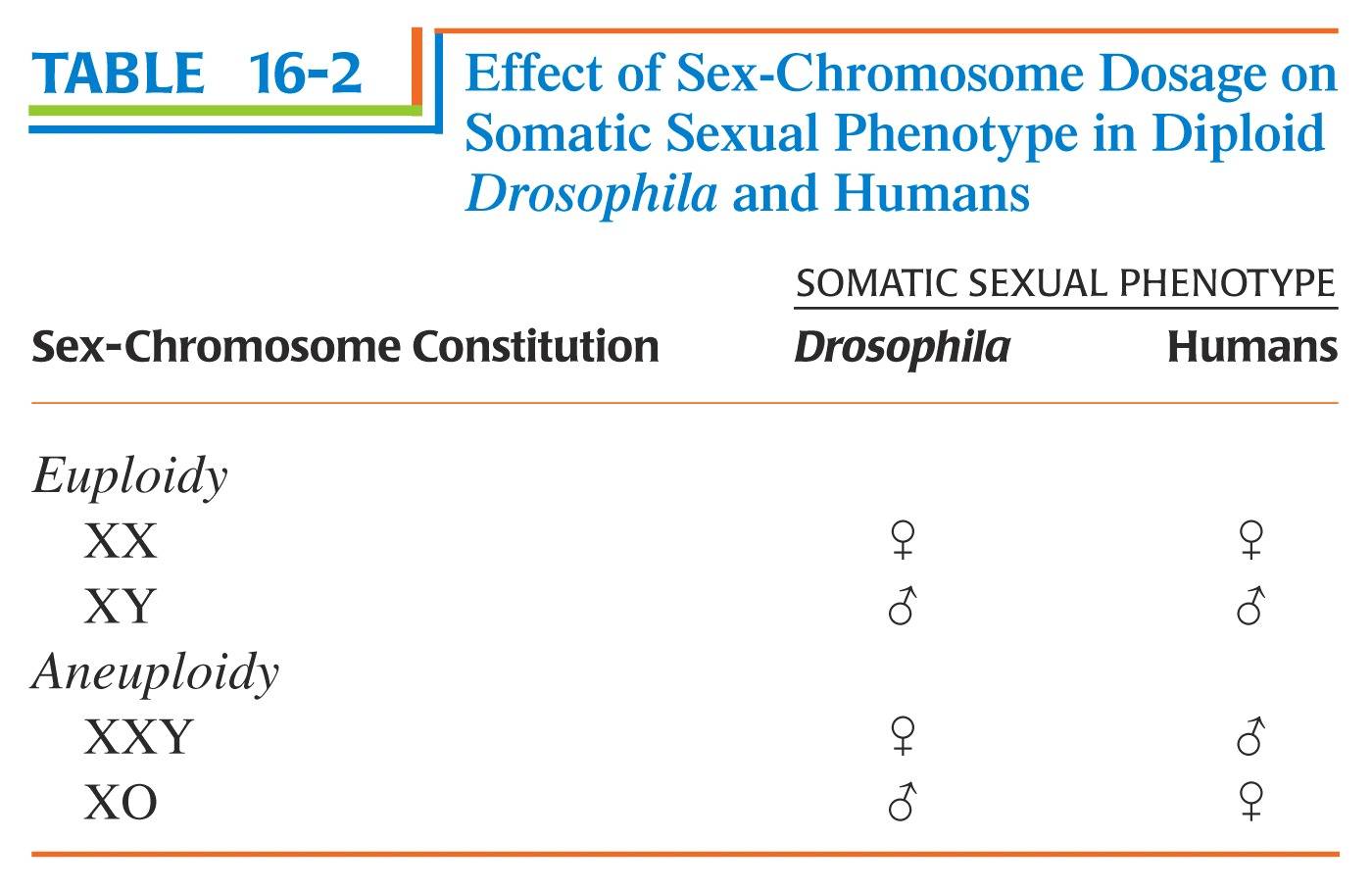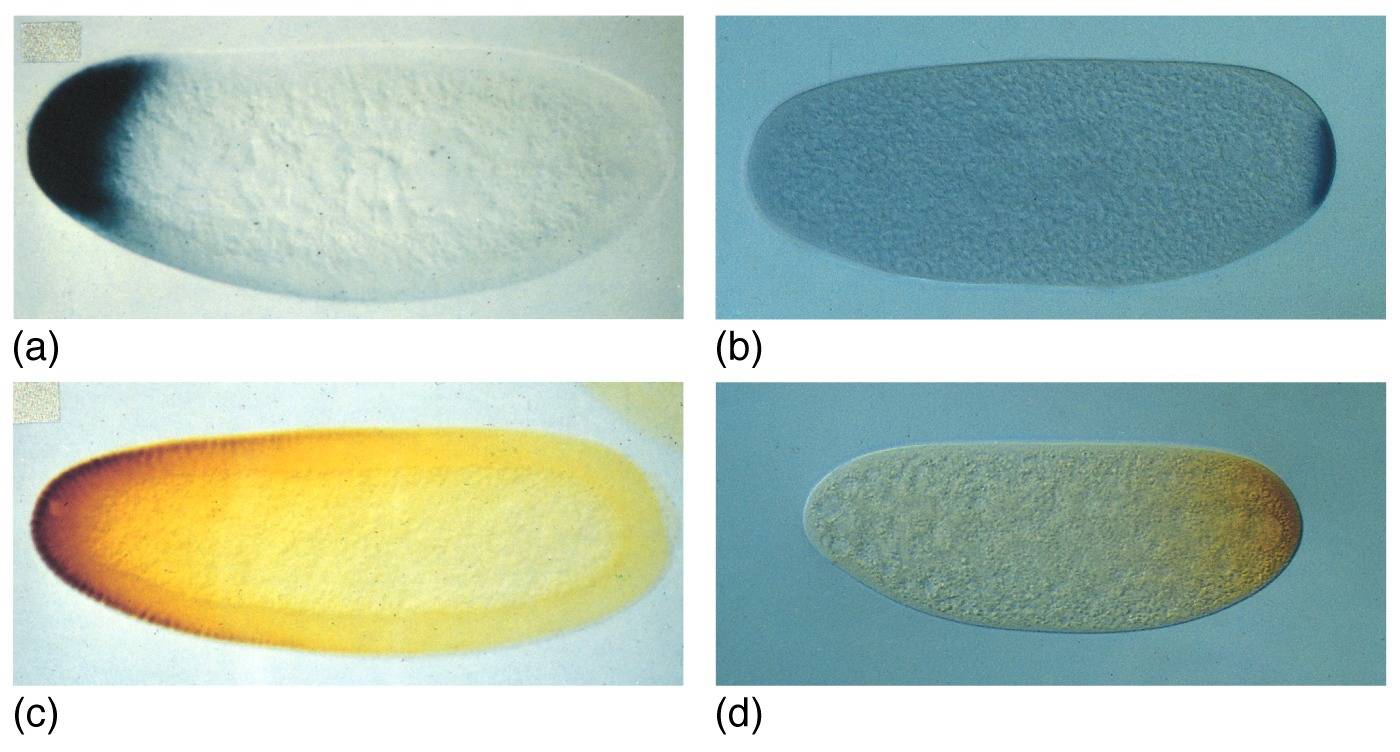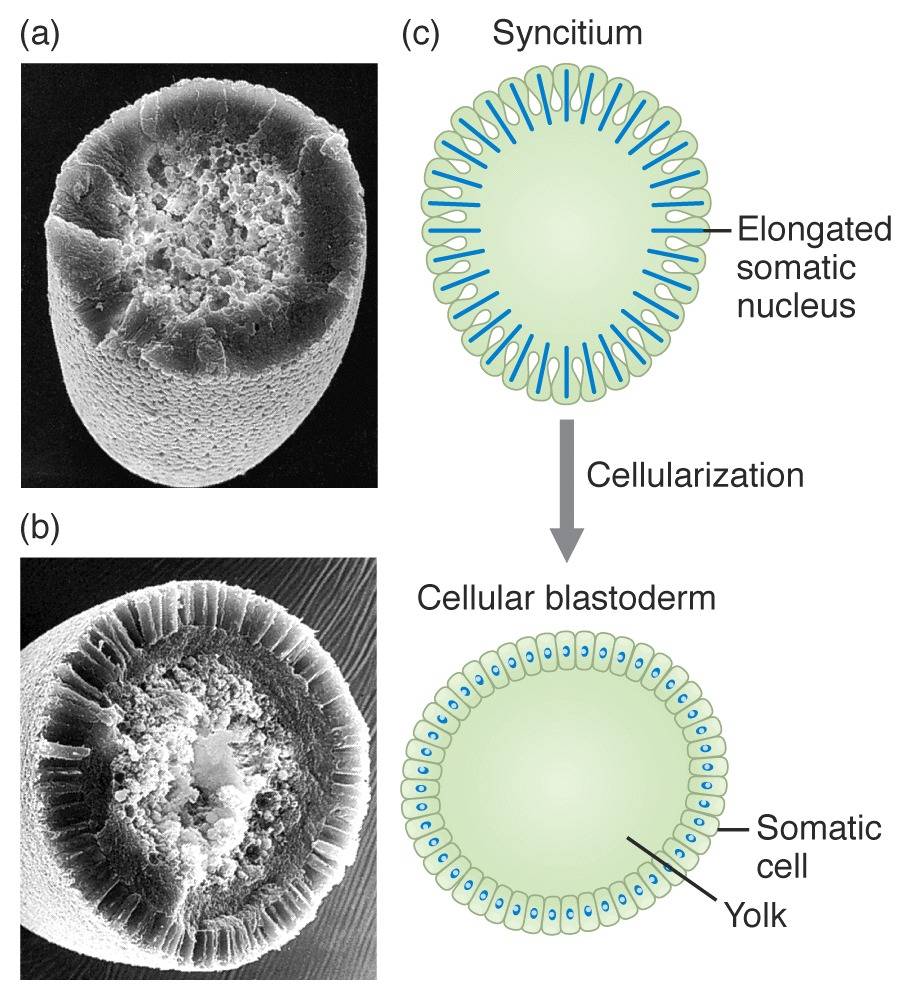The
Genetic Basis of Development
Presented
by: Caitlin Hill, Becky Richardson and Michelle Wille
 Introduction
Introduction
Sex
Determination in
Early Development: Drosophila vs Mammals
Germ Line vs Soma
Forming a
Complex Pattern
Relationship
between Animal and Plant Development.
Key
Concepts:
1. The
developmental
fates of cells with respect to anatomy is determined by the genome of
higher
organisms
2.
Developmental pathways
consist of a sequence of various regulatory steps
3. The zygote
is
totipotent
4. In the
egg, gradients
of maternally derived regulatory bodies establish polarity along the
major body
axes. These proteins control local transcriptional activation of genes
that
encode for regulatory proteins in the zygote.
5. Many
proteins that act
as master regulators of early development are transcription factors or
components of pathways that mediate signaling between cells.
6. The basic
set of genes
identified in Drosophila are
conserved in mammals and appear to govern major
developmental events
7. The
molecules that
underlie regulation in plants are different from animals, but we see
many of
the same themes.
Introduction
Different
cell types of
the body differ in the variety and amounts of the proteins that they
express.
A protein
profile can be created and differentiate due to a series of
genetic regulatory decisions that determine gene expression.
Cells commit
to cell fates: the capacity to
differentiate into different kinds of cells. The fate depends on
location and
requires a cooperative division of labour
among
participating cells. The cells fates are divided among groups of
cooperating
cells, called a developmental field.
Positional
information is
established through protein signals from within a localized source
within a
cell, usually the one cell zygote, or within a developmental field.
Through fate refinement, a population of cells
with the necessary final diversity of fates is established.
Cell lineage
dependant
mechanism can partition fates through paracrine
signaling mechanisms by neighbours
Development
is flexible: if developmental cells die,
the fates of other cells are reassigned in order to compensate.
Commitment to
fate is gradual. The first generation
of cells are totipotent, with with
time, each
successive generation is more committed.
There are two
different
types of decisions in building the embryo: binary
and complex
Regulatory mechanisms play a large
role in
developmental
decisions.
Sex
Determination
In many
species sex is
determined due to a heteromorphic
chromosome pair.
The XX/XY
mechanism is
believed to have arisen independently in many different lineages rather
than
through a most recent common ancestor.
This is
because the
mechanism of sex determination from the heteromorphic
chromosome is very different between Drosophila
flies and mammals

Germ
Line and Soma Separation
This is one
of the
earliest decisions in animal behaviour, and is an irreversible
separation.
Germ cells do
not
contribute to somatic structures, and somatic cells cannot form
gametes.
Early
separation indicates
that genetic or regulatory modification of somatic cels
can occur without affecting the genetic information of the germ line.
The cytoskeleton
is a crucial
part in this separation.
P granules,
or polar
granules are asymmetrically distributed in cells forming the germ layer
and are
transport vesicles that ride on specific cytoskeleton highways to
deliver
attached germ-cell determinants to appropriate cells.
These
molecules are
distributed by different mechanisms in different organisms including Caenoerhabcitris
elegans and Drosophila.
Forming
Complex
Patterns:
Establishing
Positional Information
Concentration gradients of the two transcription factors: BCD and HB-M proteins. Through the creation of these gradients positional information along A-P axis is established.
BCD protein encoded by bicoid gene (bcd) distributed in steeper gradient in early embryo
HB-M protein encoded by one of mRNAs of hunchback gene (hb) distributed in shallower but longer gradient

Origin of the Gradients
The gradients depend on the diffusion of protein from a localized origin: localized translation of two mRNA species, one tethered to microtubules at the anterior pole, and the other at the posterior pole of the syncitial embryo.
Cell-Cell
Signaling and the Drosophila Dorsal-Ventral
Axis
The
establishment of the
dorsal-ventral axis in the Drosophila
depends on a mechanism for positional information. This time, the
positional
information depends on extracellular proteins from localized cells in
the
developing field. The secreted proteins form a concentration gradient
of ligand
in the extracellular space which binds and activates target cells.
The Two Classes of Positional Information
(1) Localization of mRNAs within a cell
- used only in cases where developmental field begins as a single cell
- used as a way of asymmetrically distributing local determinants to progeny cells
(2) Formation
of a concentration gradient of an extracellular diffusible molecule
-employed in multicellular
developmental fields, since gradient is extracellular
-morphogen: any of various
chemicals in embryonic tissue that influence the movement
and organization of cells
by forming a concentration gradient
Utilizing Positional Information to Establish Cell Fates
Initial Interpretation of Positional Information
Positional information leads to a gradient of transcription-factor activities.
The receivers of signals are regulatory elements of genes
The protein products of certain genes are responsible for specifying cell fates.
Cardinal genes: the pattern-formation genes in Drosophila that are the zygotically acting genes directly responding to the gradients of the anterior-posterior and dorsal-ventral positional information created by the maternally expressed pattern-formation genes.
A-P cardinal genes
__________________________________________________________________________________________________________________________________________________________
Refining Fate Assignments through Transcription-Factor Interactions
The gap-gene expression stage transitions into refinement. This occurs during the time in Drosophila embryonic development when the syncitial embryo becomes fully cellularized.

During the
gap-gene expression stage the gap-gene expression pattern slices up the
A-P
axis into domains. Cellularization establishes separate cells and
within the
cytoplasm of each separate cell is a specific concentration of one or
two
adjacent gap-gene-encoded proteins. These concentrations enter the
nucleus of
the cell where they drive all further decisions.
Additional
Aspects of
Pattern Formation
This
is accomplished through positive-feedback
loops.
Cells
interact with each other through induction
or inhibition.
____________________________________________________________________________________________________________________________________________________________
Parallels
in
vertebrate and insect pattern formation
Clusters
of homeotic genes called Hox complexes in mammals and homeotic gene
complex (HOM-C)
in insects are
very similar.
The
major difference is that there is only one cluster in the insect genome
and
four clusters in the mammals.
How
can flies, mice and humans
have such similar gene sequences?
Animal and
Plant
Development
Many
important developmental pathways are ancient inventions that have been
conserved in many animal species.
BUT,
plants have very different systems from animals.
Do
the pathways we know about in animal development also apply to plant
development?
_____________________________________________________________________________________________________________________________________________________________
_____________________________________________________________________________________________________________________________________________________________